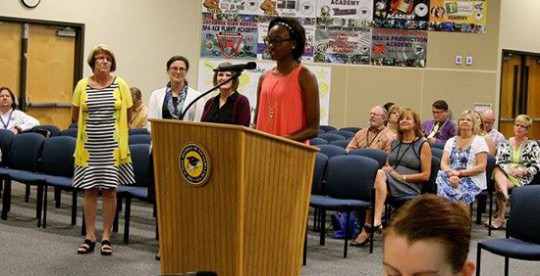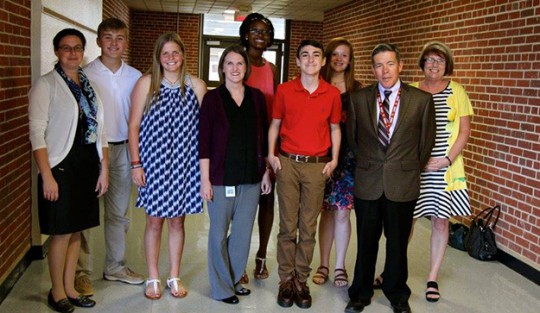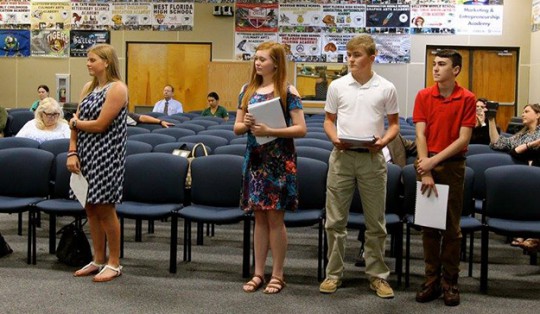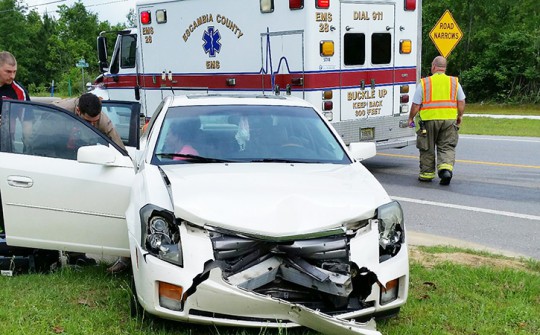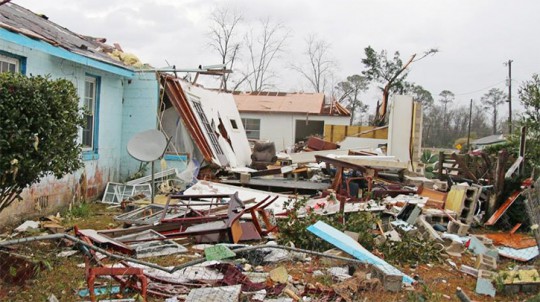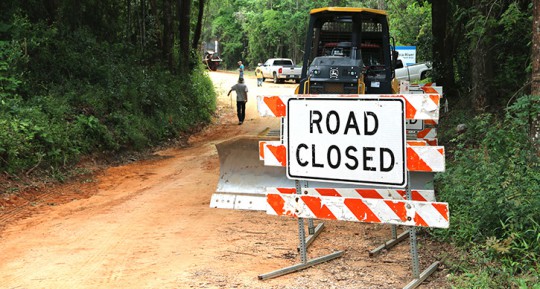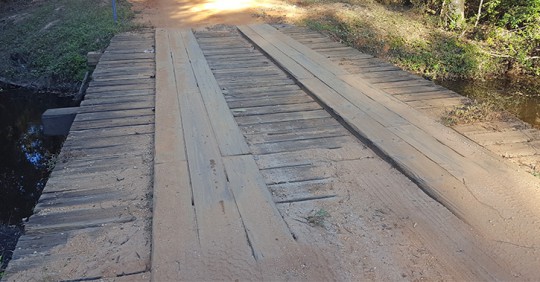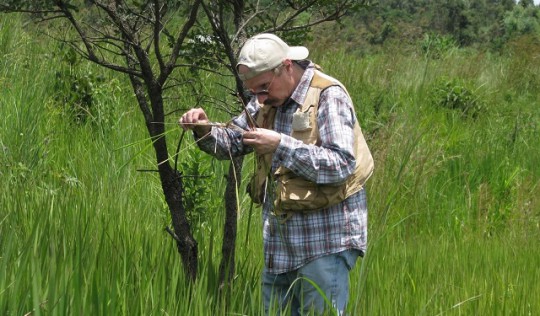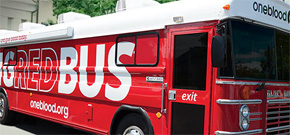Ransom Multimedia Academy Makes School Board Presentation
April 14, 2017
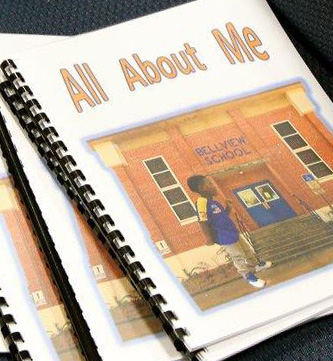 Students from the Ransom Middle School Multimedia Academy made a presentation to the Escambia County School Board Thursday afternoon during a board workshop. The students created personalized books to stimulate an interest in reading for students at Bellview Middle School. Photos by Kim Stefansson, ECSD, click to enlarge.
Students from the Ransom Middle School Multimedia Academy made a presentation to the Escambia County School Board Thursday afternoon during a board workshop. The students created personalized books to stimulate an interest in reading for students at Bellview Middle School. Photos by Kim Stefansson, ECSD, click to enlarge.
Florida Lawmakers Move Forward With No-Fault Repeal
April 14, 2017
Efforts to put the brakes on Florida’s no-fault auto insurance system are moving in the House and Senate.
But with a little more than three weeks remaining in the 60-day legislative session, and critics claiming the change would be a boon to trial lawyers and kill small-business jobs, the proposal is just starting to advance in the Senate.
Also, the bills differ on a redesign of minimum insurance coverage, with the House sponsor saying the Senate version may just be “PIP renamed.”
Thursday morning, the Senate Banking and Insurance Committee voted 8-1 to support a measure (SB 1766) that would eliminate the no-fault system and the requirement that motorists carry personal-injury protection — commonly referred to as PIP — coverage. The bill would require motorists to buy bodily-injury coverage, which most drivers in Florida already have.
A short time later Thursday, the House Commerce Committee voted 22-5 to back a repeal measure (HB 1063) that would impose a different minimum of bodily-injury coverage. That bill is now ready to go to the full House.
Under the decades-old no-fault system, motorists are required to carry $10,000 in personal-injury protection coverage. That coverage, which essentially hasn’t changed since 1979, is designed to pay medical bills after accidents.
“I’m of the fundamental belief that PIP is woefully inadequate in the 21st Century,” Senate bill sponsor Tom Lee, R-Thonotosassa, said. “It’s just lost pace with the cost and medical inflation and treating injured parties.”
The House legislation is projected to save motorists an average of about $81 a year per policy. But that is mostly due to the fact that nearly 90 percent of motorists already have some form of bodily-injury coverage, and the savings would depend on where motorists live.
The change could affect health-care premiums, according to a House staff report.
The Senate proposal, which would require more overall coverage and gradually impose a higher minimum of bodily-injury coverage, is projected at providing $9 to $12 a year savings, depending on where motorists live.
Under Lee’s proposal, starting in 2018, motorists would be required to have $20,000 in personal bodily-injury coverage and $40,000 for multi-person bodily-injury coverage. The minimums would grow two years later to $25,000 and $50,000 and to $30,000 and $60,000 in 2022.
Motorists would also be required to have $5,000 in medical-payments coverage, similar to a component in no-fault.
Sen. Rene Garcia, R-Hialeah, cast the lone vote against the Senate measure, due in part to his desire for the bill to include a $2,500 set-aside for physician emergency-room care.
“That’s extremely important for me,” Garcia said. “I also have a concern that this is a cost shift from auto-insurance to health-insurance policies, and it does nothing to ensure that rates will go down for those that need it the most.”
The House bill, sponsored by Rep. Erin Grall, R-Vero Beach, would take effect Jan. 1. It would mandate motorists get at least $25,000 in coverage for bodily injury or death and $50,000 for bodily injury or death of two or more people.
Medical payments coverage is not included in the House proposal, and Grall doesn’t support its inclusion.
“I’m concerned that if we just rename PIP ‘med pay,’ we will have the same problem,” Grall said.
The proposals to change the auto-insurance system come as lawmakers continue to express dissatisfaction with a 2012 effort to reform the no-fault law. That effort was championed by Gov. Rick Scott and state Chief Financial Officer Jeff Atwater.
The 2012 law, which set benchmarks for insurers to lower rates, was considered a last-ditch effort to maintain the system after rates increased due to an increase in fraudulent claims.
The law, in part, required people involved in crashes to seek treatment within 14 days and allowed up to $10,000 in benefits for emergency medical conditions, while putting a $2,500 cap on non-emergency conditions.
A state-commissioned study in September by Illinois-based Pinnacle Actuarial Resources determined the 2012 reform law resulted in an estimated statewide average savings in PIP premiums of 15.1 percent.
However, the Office of Insurance Regulation reported that while rates dropped for the first two years, they have grown since 2015 by 25.7 percent — driven by increases in medical care, costs of vehicle body work and distracted drivers.
Blue Wahoos Win Third Straight
April 14, 2017
Pensacola Blue Wahoos pitcher Luis Castillo pitched his second strong outing, allowing just one run on three hits in seven innings.
 In his first start for Pensacola, after being traded to the Cincinnati Reds from the Miami Marlins on Jan. 19, Castillo allowed one run on three hits in six innings.
In his first start for Pensacola, after being traded to the Cincinnati Reds from the Miami Marlins on Jan. 19, Castillo allowed one run on three hits in six innings.
Castillo’s performance helped the Blue Wahoos win its third straight game, 4-1, over the Biloxi Shuckers Thursday night at MGM Park in front of 2,545. It also gave Pensacola a, 2-0, lead in the five-game series.
Castillo, the Red’s No. 7 prospect according to MLB Pipeline, picked up his first victory after getting a no-decision in his first start. His ERA is 1.36 after two games. In Miami’s organization, Castillo who can touch 100 mph with his fastball, was Minor League Pitcher of the Year and the No. 2 prospect.
The Blue Wahoos sent seven hitters to the plate in the fifth inning and broke out with three runs to take the lead, 3-0. Its first two runs came when center fielder Brian O’Grady doubled to drive in both left fielder Gabriel Guerrero, who had singled, and first baseman Angelo Gumbs, who earned a walk. Guerrero is hitting .333 this season. Then third baseman Alex Blandino drove in O’Grady with his third double and fourth RBI in two games against Biloxi.
Pensacola tacked on another run to go up, 4-0, in the sixth when right fielder Aristides Aquino walked and stole second. Blue Wahoos second baseman Josh VanMeter, who is hitting .316, then doubled to right field to score Aquino.
Biloxi scored its only run when pinch hitter Nick Ramirez blasted a solo home run to right field to make the score, 4-1.
Once again, the Pensacola bullpen blanked the opposition. In his one inning, Ariel Hernandez gave up one hit, one walk and struck out two. Ismael Guillon earned his first save of the season, even though, he gave up two hits and had to work out of a jam with Biloxi runners on first and third.
Tate Falls To Pace
April 14, 2017
Pace 6, Tate 2
The Tate Aggies lost a crucial 7A district game to Pace Thursday night 6-2.
The Aggies took a 1-0 lead in the second inning when Trey LaFleur singled with one out. But the game took a turn in Pace’s favor quickly in the bottom of the fifth with six runs for the Patriots.
LaFleur was 2-3 with a run, a double and a RBI. Also for Tate: Logan Blackmon R; Kyler Hultgren 1-3.
Tate will host Pace Friday night.
Pace 3, Tate 2 (JV)
Century Accepting Tornado Damage Housing Assistance Applications
April 13, 2017
The Town of Century is now taking applications for housing rehabilitation assistance for houses that were damaged as a result of the February 15, 2016, tornado.
Only residents whose housing units were damaged by the tornado are eligible to apply. To qualify for assistance, the home that was damaged must be located inside the city limits of the Town of Century and must have a total household income at or below the following criteria:
Applicants whose total gross household income exceeds the income limits for their size household will not be considered for rehabilitation grant assistance.
Persons interested in being considered for inclusion in this program must call Samella Myles at the Century Town Hall at (850) 256-3208 between the hours of 8:00 am and 3:30 pm and ask that their name be placed on the housing assistance waiting list. Only those who call in to Century Town Hall will be placed on the waiting list. The deadline to be placed on the interested applicant list is Monday, May 1, 2017.
NorthEscambia.com file photo.
Florida Ready To Take Another Look At Bears, Bear Hunts
April 13, 2017
Florida game officials will get an update next week on the state’s growing black bear population, a discussion animal-rights supporters contend is a first step toward holding a hunt later this year.
A Florida Fish and Wildlife Conservation Commission staff update that will be presented April 19 at the Florida Public Safety Institute in Havana — northwest of Tallahassee — doesn’t include “anything specific” about holding a bear hunt this year, said Thomas Eason, director of the commission’s habitat and species conservation division.
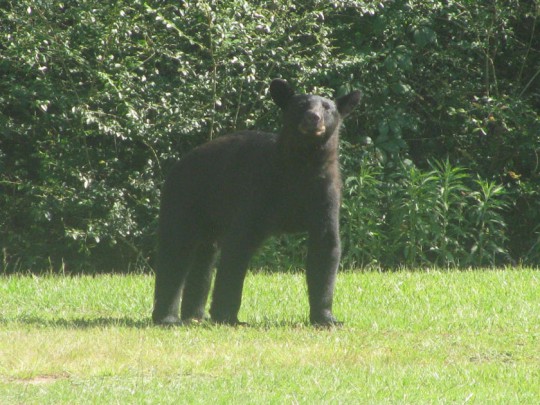 “However, with that said, at all of the previous commission meetings recently, the public has come and talked about bear hunting,” Eason said Monday. “We anticipate that likely will happen again, and our commissioners can always engage on that topic if they wish to do so.”
“However, with that said, at all of the previous commission meetings recently, the public has come and talked about bear hunting,” Eason said Monday. “We anticipate that likely will happen again, and our commissioners can always engage on that topic if they wish to do so.”
Hunting backers have argued that a hunt is one way to manage bear populations and to reduce potentially dangerous bear-human interactions.
A one-page agenda item on bear management for the meeting says, “This presentation is for informational purposes and any direction the commission may want to provide staff.”
Bear hunting has been a controversial issue since the commission in 2015 allowed the first bear hunt in more than 20 years. The commission decided against holding a hunt in 2016.
Animal-rights supporters consider such hunts as trophy excursions and question the agency’s bear population numbers.
“The bear population is so fragmented, and there are so many bears hit by cars, we should be conserving them and helping connect the different subpopulations with safe passages over interstates and things like that,” said Kate MacFall of the Humane Society of the United States. “Floridians don’t want a hunt.”
Chuck O’Neal of the Seminole County group Speak Up Wekiva said that if the commission plans to start 2017 hunt discussions, it will happen at this month’s meeting.
The commission meets quarterly, and directions would have to be given at the meeting in Havana for staff to outline a fall hunt — from the days and locations to permit requirements — that could be voted on at a July meeting in the Kissimmee area and a late September meeting in Okeechobee.
“They need to let what they’re doing take effect,” said O’Neal, whose group was among those that went to court to try to stop the 2015 hunt in court. “The number of nuisance calls is down. It’s well known the number of bear conflicts, where there is a result of injuries, is way down. It’s working. There is no reason why they should even contemplate even having a hunt if what they’re doing is working.”
After 304 bears were killed in two days during the 2015 hunt, the commission narrowly rejected a hunt last year. The decision was to give the agency more time to build a case for future hunts and to provide more time for non-lethal efforts to reduce human-bear conflicts to take hold.
The agency used money from the state and through fees paid for bear hunting permits in 2015 to spread $825,000 across 12 counties — Seminole, Lake, Orange, Santa Rosa, Collier, Franklin, Gulf, Leon, Marion, Putnam, Volusia and Wakulla — to increase the use of bear-proof trash containers.
Also, after the 2015 hunt, the agency completed a population estimate that raised the number of bears in the state from just over 3,000 to 4,350.
“A growing bear population is good to see,” Eason said. “A lot of us have worked hard to recover bears in Florida. They continue to do well, and that is why we are looking at all aspects of bear management.”
The staff update comes as the number of bear-related calls has fallen from 6,688 in 2014 to 6,088 in 2015 and 5,132 last year, according to the state agency.
In February, Eason advised state lawmakers that a number of factors could be involved in the reductions in calls: an abundance of natural foods that would make bears less likely to come into more-urban areas; work in 2015 and 2016 to relocate about 100 bears that were generating the most calls; and the impact of a 2015 hunt and the public reaction to the hunt.
“There’s been strong reaction to the bear hunt,” Eason told members of the House Agriculture & Natural Resources Appropriations Subcommittee. “We definitely get reports that people are not calling in when they maybe would have in the past.”
Jacki Lopez, the Center for Biological Diversity’s Florida director, noted that a recent Colorado Parks and Wildlife study found that an increase in bear-human conflicts was more a sign that the creatures adapted to urban expansion into their habitats rather than a growth in population.
“It supports our position that if the real reason for a hunt is to address a growing so-called problem bear population, hunting is not the correct tool to address that problem,” Lopez said in an email.
by Jim Turner, The News Service of Florida
NorthEscambia.com file photo.
Sunny And Warm
April 13, 2017
Here is your official North Escambia area forecast:
Thursday Night: Patchy fog after 1am. Otherwise, mostly clear, with a low around 59. South wind around 5 mph becoming calm in the evening.
Friday: Mostly sunny, with a high near 83. Light and variable wind becoming southeast 5 to 10 mph in the morning.
Friday Night: Partly cloudy, with a low around 60. South wind around 5 mph becoming calm in the evening.
Saturday: Mostly sunny, with a high near 82. Southeast wind 5 to 10 mph.
Saturday Night: Partly cloudy, with a low around 60. South wind around 5 mph becoming calm after midnight.
Sunday: A 20 percent chance of showers and thunderstorms. Mostly sunny, with a high near 83. Light and variable wind becoming south 5 to 10 mph in the morning.
Sunday Night: Partly cloudy, with a low around 61. South wind around 5 mph becoming calm in the evening.
Monday: A 20 percent chance of showers and thunderstorms. Mostly sunny, with a high near 83.
Monday Night: Partly cloudy, with a low around 60.
Tuesday: A 20 percent chance of showers and thunderstorms. Mostly sunny, with a high near 84.
Tuesday Night: Partly cloudy, with a low around 61.
Wednesday: Mostly sunny, with a high near 84.
Replacement Of Escambia County’s Last Wooden Bridge Nearly Complete
April 13, 2017
Work to replace the last all-wooden bridge in Escambia County is nearing an end.
Contractors stated work to replace the 60-year old structurally deficient bridge on over Pritchett Mill Creek on Bluff Springs Road last November with anticipated completion by March.
The construction is nearly done, and the Florida Department of Transportation has requested a substantial completion inspection for April 20, according to a county spokesperson.
The scope of work included clearing, grading, drainage, paving, signage and bridge construction approximately 300 feet east and west of the intersection of Pritchett Mill Creek and Bluff Springs Road. There are no permanent residences located beyond the road closure, but Escambia River and camp access via Bluff Springs Road was cut off with the closure.
Pictured: The road closure on Bluff Springs Road as seen Wednesday afternoon, April 12. Pictured below: The last all-wooden bridge in Escambia County as seen in early November 2016. NorthEscambia.com photos, click to enlarge.
UF/IFAS Researchers Find Potential Bugs To Eat Invasive Cogongrass
April 13, 2017
by UF/IFAS Extension Service
A few bugs may be able to chew up some cogongrass, a noxious weed that elbows out pasture grass, golf course greens and valuable ecosystems, a University of Florida Institute of Food and Agricultural Sciences researcher says.
A worldwide research team led by UF/IFAS entomology professor James Cuda and retired entomology professor Bill Overholt found species in Japan, East Africa and Indonesia that might help in the battle against cogongrass.
Among the arthropods they found, Cuda and his team discovered a midge from Indonesia that attacks cogongrass. Cuda and his team are focusing on the Orseolia javanica midge that causes cogongrass to produce linear galls at the expense of leaves. However, when scientists brought the arthropods back to the quarantine facility at the UF/IFAS Indian River Research and Education Center in Fort Pierce, Florida, they did not mate and increase in population.
So, scientists must conduct more research to determine how to rear the midge in the laboratory in order to evaluate its host specificity and impact on cogongrass, a rather ubiquitous weed in Florida and the southeastern U.S., said Cuda, a biological weed control specialist with UF/IFAS.
“This invasive grass infests cattle pastures, golf courses, lawns and also thrives in poor soil conditions such as ditch banks, roadside and railroad rights-of-way as well as reclaimed phosphate mining areas,” he said, adding that it grows quickly and alters the ecology of habitats it invades.
Cogongrass, introduced in the U.S. in the early 1900s as packing material and as livestock forage grass, causes the most expensive losses in pine plantations, where it outcompetes native ground cover and increases the frequency and intensity of fires, Cuda said. It also displaces native vegetation in sand hill communities in Florida.
Currently, cogongrass control is accomplished with mowing and herbicides, which can be costly and are not always effective. Cuda cited a 2009 report that showed the state of Alabama spent $6.3 million of federal stimulus funds exclusively for chemical control of the weed.
“Biological control using natural enemies from the native range of cogongrass has received little attention, and no biological control agents have been introduced anywhere in the world,” Cuda said. “That’s why we are investigating biocontrol agents for cogongrass. Biological control is more sustainable and can be integrated with conventional controls.”
The latest research on biological control of cogongrass appears in the journal Florida Entomologist.
Pictured: A worldwide research team led by UF/IFAS entomology professor James Cuda, seen above, and retired entomology professor Bill Overholt found species in Japan, East Africa and Indonesia that might help in the battle against cogongrass. Photo for NorthEscambia.com, click to enlarge.
Blood Drive Today At Library
April 13, 2017
The Bloodmobile will be at the Century Branch Library at 7991 North Century Boulevard from noon until 4 p.m. today, April 13. To donate, just look for the Big Red Bus. Sponsored by OneBlood.


